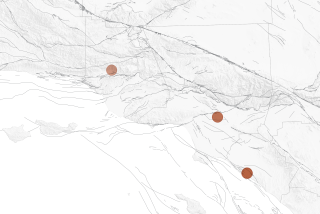Seismologists Strike It Rich in China : 2,000 Years of Earthquakes Recorded in Historical Detail
- Share via
SAN FRANCISCO — U.S. scientists conducting research in China are finding an extraordinary catalogue of earthquakes that is rich in historical detail, even down to the exact time the quakes occurred hundreds of years ago.
This history of 2,000 years, coupled with an eagerness by Chinese leaders to cooperate, is giving scientists a unique opportunity to test theories on periodicity and frequency of major quakes.
“We’re lucky to get 200 years (of historical details) here,” said Robert E. Wallace, chief scientist of the U.S. Geological Survey’s office of earthquake studies in Menlo Park.
Wallace, interviewed during the annual convention of the American Geophysical Union here, said U.S. scientists have studied detailed records of Chinese earthquakes dating back to AD 180.
“One broke the Great Wall of China in 1739,” he said. “The history is all recorded,” including the precise areas affected by the quake.
About 30 Chinese scientists are attending the convention here as part of an international cooperative project under a U.S. State Department program.
Chinese interest is stimulated by the fact that the most deadly earthquakes in history have struck within that nation’s borders. The Xian quake of 1556 killed 820,000 people, by far the most destructive quake ever. Nearly a quarter of a million people died in a major quake there a few years ago.
However, China is less active seismologically than many other areas of the world. Earthquakes occur there less frequently than in California, for example, but when they do, they strike with a vengeance, Wallace said. China also lost many years of scientific research during the Cultural Revolution, when scientists were sent off to labor camps.
The remaining historical record, however, is of immense importance to scientists who are trying to determine if major quakes occur in groupings, followed by long intervals of dormancy, or if they occur regularly and can be predicted on the basis of a pattern of reoccurence.
It is unlikely that many quakes in China follow the same patterns as those in California, Wallace said, because China is in the central section of the Asian tectonic plate, one of the huge sections of the Earth’s crust that is migrating slowly around the globe. California, by contrast, is on the cutting edge, where two plates meet.
However, there undoubtedly are many similarities, and research in widely separated sectors of the globe could help explain quakes wherever they occur, Wallace said.
In order to understand the “pulse of the Earth,” it is necessary to know much more about the global “driving force” that causes earthquakes, he added.
He said 10 major countries around the world are cooperating in a joint effort to study earthquakes on a global scale.
More to Read
Sign up for Essential California
The most important California stories and recommendations in your inbox every morning.
You may occasionally receive promotional content from the Los Angeles Times.













